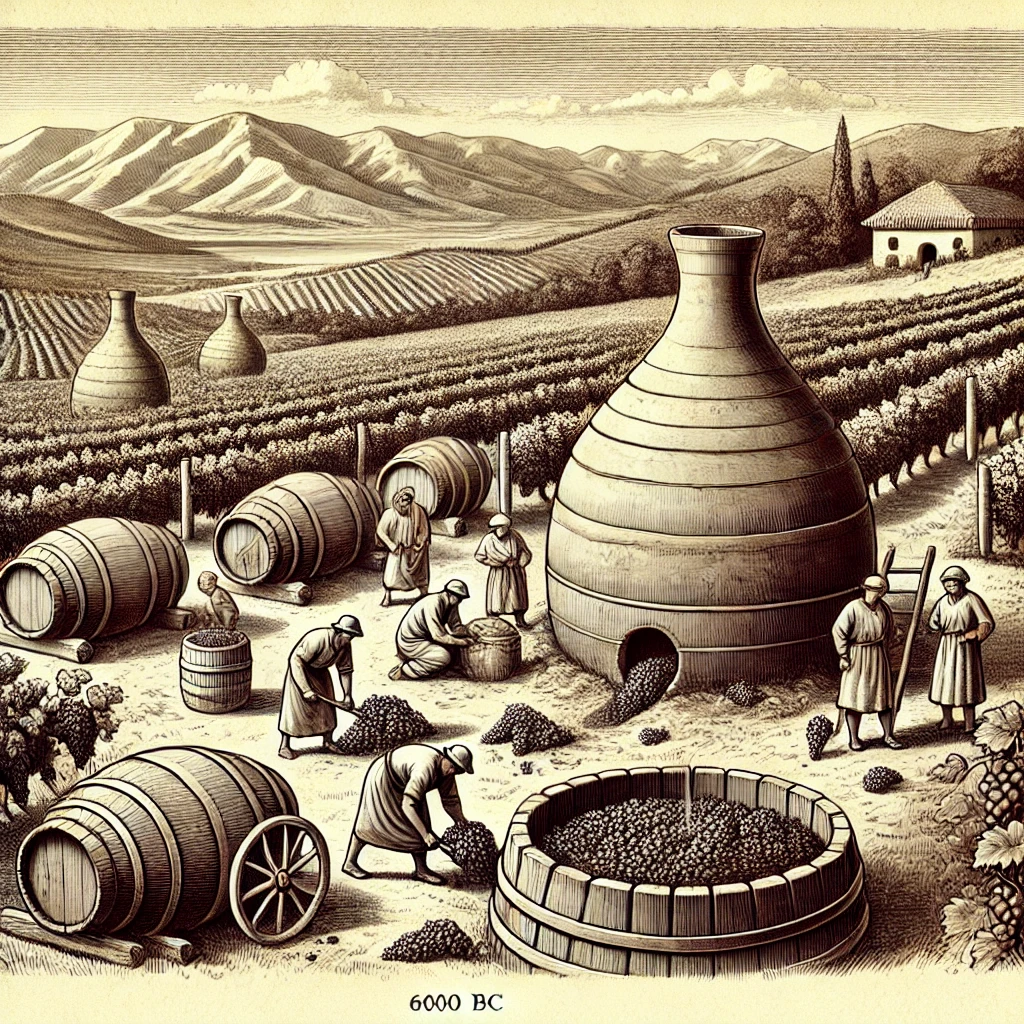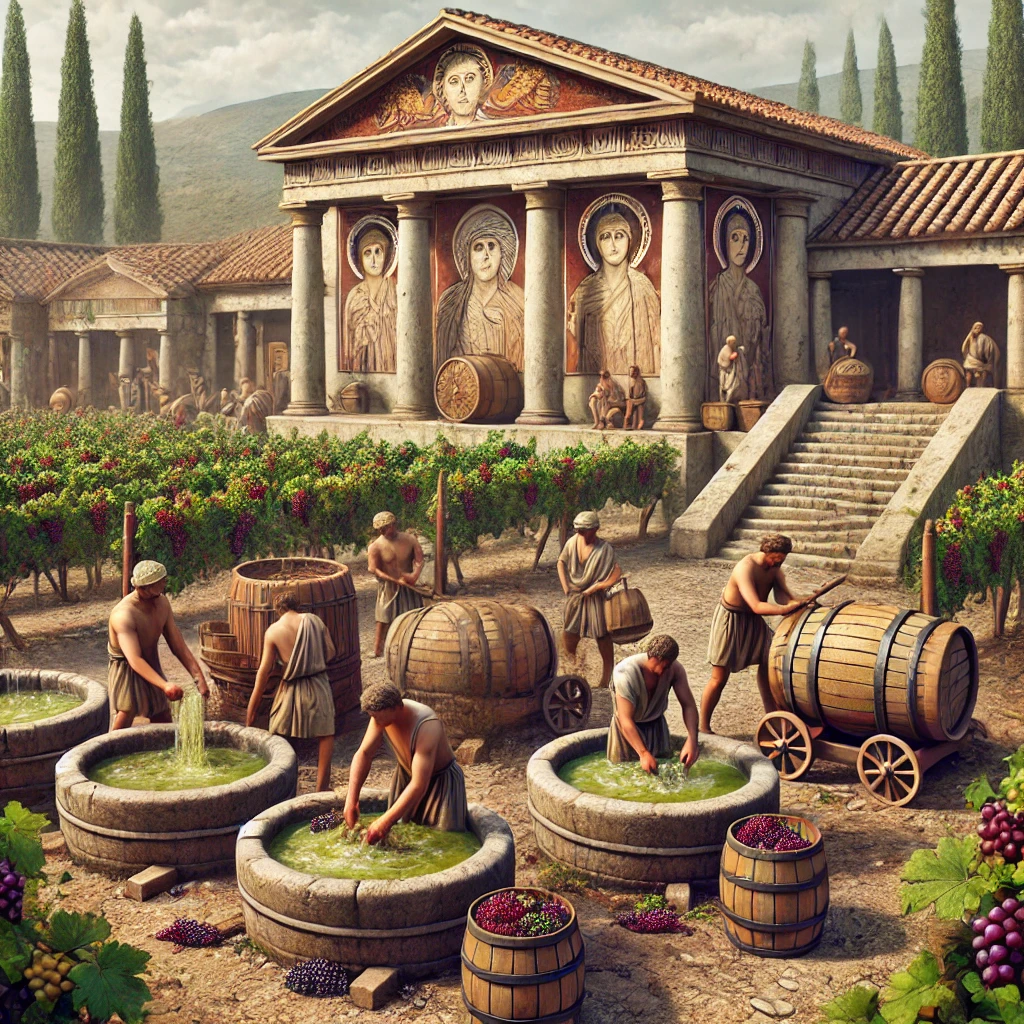Introduction
Humans have enjoyed wine for thousands of years. It is not just a drink but a symbol of culture, tradition, and celebration. From ancient civilizations to modern vineyards, wine has played an important role in history. Let’s examine how wine started, spread, and evolved over time.

1. How Was Wine First Made?
Discovery in Georgia (6000 BC)
The earliest evidence of winemaking comes from Georgia, around 6000 BC. People stored crushed grapes in large clay jars called qvevris. The grapes fermented naturally over time, creating the first wine. The tradition of using qvevris continues in Georgia today, making it one of the oldest winemaking regions in the world.
Mesopotamia and Egypt (5000-3000 BC)
By 5000 BC, wine was being made in Mesopotamia (Iraq) and Iran. The Egyptians used wine for religious ceremonies and buried bottles in the tombs of pharaohs to take with them to the afterlife. They also began using grape presses to extract juice more efficiently. Egyptian paintings and hieroglyphs depict winemaking, showing that it was an important part of their culture.

2. Wine in Ancient Civilizations
Greek Influence (1500 BC – 500 BC)
The Greeks believed wine was a gift from Dionysus, the god of wine. They held symposiums, gatherings where people discussed philosophy while drinking wine. The Greeks also spread wine culture to Italy and France. They experimented with different grape varieties and developed early methods of aging and preserving wine.
Roman Expansion (200 BC – 400 AD)
The Romans improved winemaking techniques and planted vineyards across France, Spain, and Germany. They created wooden barrels for storage and transport, making wine more accessible. Romans also classified wines based on grape variety and region, influencing modern wine standards. Roman soldiers carried wine on military campaigns, helping spread vineyards throughout Europe.
3. The Role of Monks in the Middle Ages (500-1500 AD)
After the fall of the Roman Empire, monasteries in France and Italy kept winemaking alive. Monks experimented with different grape varieties and perfected the famous Burgundy and Champagne wines. The Catholic Church used wine in religious ceremonies, ensuring its continued importance. Monasteries owned some of the finest vineyards, and their detailed records helped improve winemaking techniques.
4. Wine Travels the World (1500s – 1800s)
Exploration and Trade
During the Age of Exploration, European settlers brought wine to the Americas, Australia, and South Africa. Spanish missionaries planted the first vineyards in California, while the Portuguese and French introduced winemaking to South America.
In South Africa, Dutch settlers planted vineyards in the 1600s, producing wines that were shipped to Europe. Wine became an important part of trade routes, with fortified wines like Port and Sherry gaining popularity for their long shelf life.
Industrial Revolution (1800s – 1900s)
The 19th century saw major improvements in winemaking. Scientists like Louis Pasteur studied fermentation, making wine production more predictable. Glass bottles and cork stoppers became popular, improving wine storage and aging. The development of controlled fermentation techniques allowed winemakers to produce wine with more consistency and better flavours.

5. Wine in Modern Times (1900s – Today)
Prohibition in the USA (1920-1933)
In 1920, the U.S. government banned alcohol, nearly destroying the wine industry. However, small amounts of wine were still allowed for religious use. After Prohibition ended in 1933, winemaking slowly recovered. Many wineries had to restart from scratch, but some survived by making sacramental wine for churches.
The Rise of California Wine (1976 – Present)
In 1976, a blind tasting event in Paris, known as the Judgment of Paris, shocked the world when California wines outperformed famous French wines. This put Napa Valley on the global wine map, increasing demand for American wines. Today, California is one of the largest wine-producing regions in the world, alongside France, Italy, and Spain.
Wine Today
Today, wine is produced in over 70 countries. New trends include:
- Organic and biodynamic wines
- New wine regions emerging in China and India
- Wine tourism growing in France, Italy, and California
- Technology improving wine production and storage
- The rise of natural and low-intervention wines
The global wine industry is worth hundreds of billions of dollars, and wine consumption continues to grow. Wine is now enjoyed in every corner of the world, from casual dinners to grand celebrations.
Conclusion
Wine has been a part of human history for over 8,000 years. From ancient clay jars to modern vineyards, it has evolved but remains a symbol of celebration and tradition. Today, wine lovers around the world continue to explore new flavours and enjoy its rich history.




